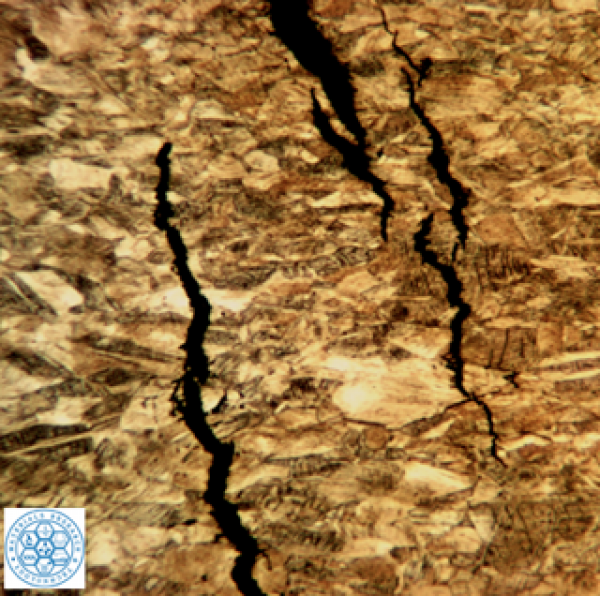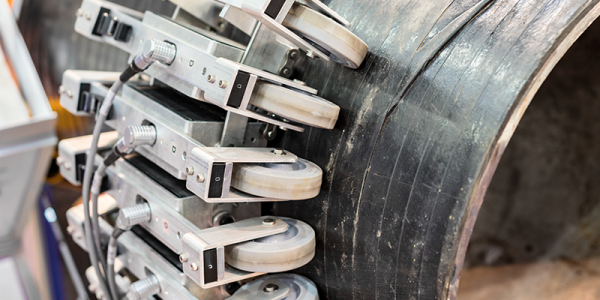Liquid Penetrant Testing, also referred to as penetrant testing (PT), liquid penetrant examination (LPE), and dye penetrant testing (DP), is a nondestructive examination (NDE) method that utilizes fluorescent dye to reveal surface flaws on nonporous materials (metals, plastics, or ceramics) which might not otherwise be visible.
History and Development
Starting in the 18th century, inspectors in the railroad industry used the “oil and whiting method” to detect defects in railroad wheels. This method involved immersing the pre-cleaned part in hot oil, wiping it dry, and then coating it with a white chalk that was typically mixed with alcohol. Once the alcohol evaporated, a contrasting white surface layer of chalk remained, which also acted as a “blotter” that aided the oil being drawn back to the surface to reveal the presence of surface flaws. This is the earliest documented use of the liquid penetrant examination technique.
Methodology
Liquid penetrant testing works via the principle of “capillary action,” a process where a liquid flows into a narrow space without help from gravity. The liquid is then drawn out with a chalk-like developer.
A critical step of the liquid penetrant testing process is surface preparation. When examining any part or piece of equipment for defects, the surface must first be cleaned thoroughly of all contaminants that may prevent the liquid from flowing into the flaws. Once the surface is properly cleaned, the dye penetrant is then applied and allowed to sit on the surface long enough for the liquid to penetrate and seep into any defects. Once enough time has passed, the excess penetrant is carefully wiped off the surface. The developer is then applied to draw the penetrant back to the surface where it can be easily seen. After inspection, the surface should be cleaned of any remaining developer and penetrant.
Industry Applications
Liquid penetrant testing is a popular technique for in-service inspections on nonporous materials because it is quick, economical, and requires minimal training when compared to other NDE methods. It is primarily used to detect surface defects such as hairline cracks, surface porosity, leaks in new equipment, and fatigue cracks on in-service components.
Liquid penetrant testing can be used to detect surface flaws in pressure vessels, clad vessel linings, valves and their components, machined parts, castings and forgings; however, it’s most commonly used to inspect welds and weld overlays. For welds, extra care should be taken because if the material is not properly sealed, the liquid dye can penetrate through the weld and contaminate fluids or cause defects if further welding is performed in the future.
While this method is effective due to its simplicity and accuracy, it does have its share of disadvantages as well. Liquid penetrant examination can only detect flaws on the surface. For subsurface flaws, techniques like magnetic particle testing (MPT), ultrasonic testing (UT), or eddy current testing (ECT) may be more appropriate. It is also most effective on smooth surfaces, which can make it unsuitable for some parts.
Relevant Codes and Standards
- ASTM E1417, Standard Practice for Liquid Penetrant Testing, is a standard published by ASTM International that establishes the minimum requirements for conducting liquid penetrant examination of nonporous metal and nonmetal components.
References
- Butz, J., 2012, “The Evolution of Nondestructive Testing,” Inspectioneering Journal, 18(3), pp. 20-21.
- Worman, J., 2011, “Liquid Penetrant Testing,” The National Board of Boiler and Pressure Vessel Inspectors, https://www.nationalboard.org/index.aspx?pageID=164&ID=374.
Related Topics
- Acoustic Emission Testing (AET)
- Advanced Ultrasonic Backscatter Technique (AUBT)
- Eddy Current Testing (ECT)
- Electro Magnetic Acoustic Transducers (EMAT)
- Guided Wave Ultrasonics (GWUT)
- Infrared Inspection
- Magnetic Flux Leakage (MFL)
- Magnetic Particle Testing (MPT)
- Meandering Winding Magnetometer Array (MWMA)
- Pulsed Eddy Current (PEC)
- Radiography
- Remote Field Eddy Current (RFEC)
- Ultrasonic Testing (UT)
Relevant Links
Topic Tools
Share this Topic
Contribute to Definition
We welcome updates to this Integripedia definition from the Inspectioneering community. Click the link below to submit any recommended changes for Inspectioneering's team of editors to review.
Contribute to Definition






















